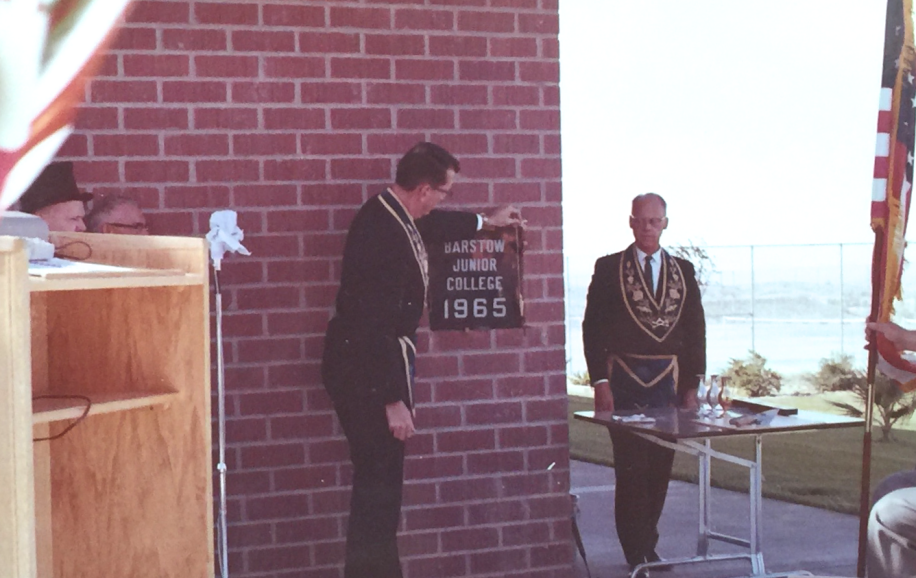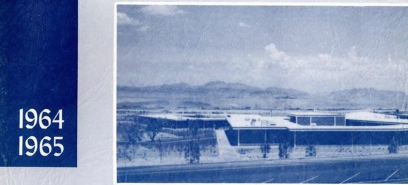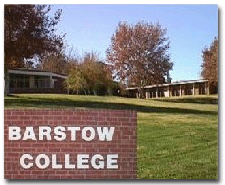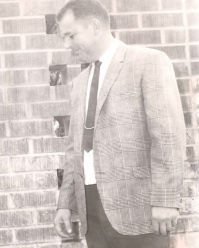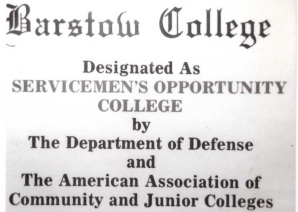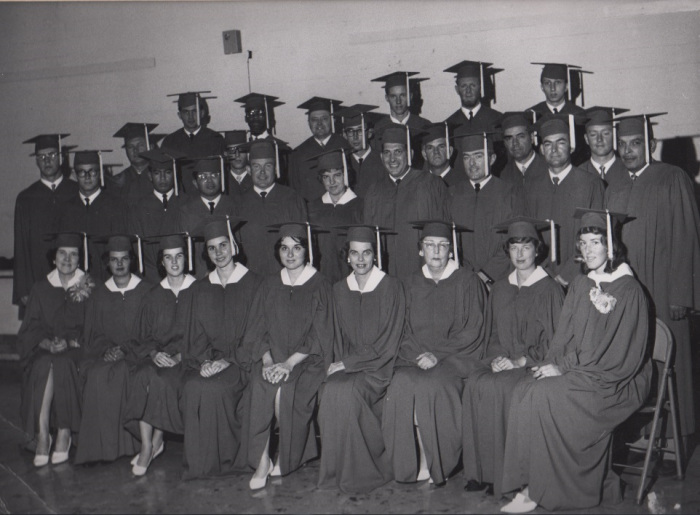New College Gymnasium Dedication, 1965
College Beginnings: The 1960s
In the late 1950s, the San Bernardino County Board of Supervisors voted for a Junior College tax. By 1959, over $127,000 in the junior college tax was collected from the Barstow community. Barstow and Mojave River Valley residents were concerned that young people seeking higher education were forced to leave their homes and relocate to colleges and universities away from the area. In 1959, the community voted overwhelmingly to support a local community college. (In those days, community colleges were called Junior colleges.)
The community wanted their tax dollars and their young people to stay home, become college educated and develop regional sustainable futures. According to Dr. Charles Chapman, the college director, “Practically none of this $127,000 was spent locally. This year…calls for a 42 cent tax rate. This will provide sufficient funds to operate a full-time college program and virtually all of these funds will be spent locally for…instructor’s salaries, utilities and the operation of the Barstow Junior College program.” (Desert Dispatch, 1960)
Goals for the college were clear from its very beginning. The school offered vocational training and occupational education, lower division university programs to ensure academic preparation for transfer to four-year colleges and universities and general education to provide intellectual and social foundations enabling students to become effective members of society. According to the college’s published philosophy:
The preservation and development of any society is dependent…upon the education of its people. This premise has particular significance in a democratic society, where the individual must make choices and accept responsibilities; for the strength of such a society is dependent upon the understanding, enlightenment and participation of its members. (Barstow Catalog. 1966)
From its opening days, the college presented a diverse and multi-ethnic student body. The community combination of Californios, long-settled Spanish New Mexican families, indigenous Native Americans, African Americans, and Euro Americans was evident in students and student leadership. Additional cultural diversity was supported by the presence of the United States Marine Corps at Nebo and Yermo bases and the National Training Command at Ft. Irwin, forty five miles away from Barstow. Barstow College and the military have always maintained close and cordial relations.
In a published faculty statement, teachers presented their goals for the college mission:
…In an educational system serving a free society, recognition must be given to the natural and social forces affecting man, the elements of learning common to all, and the variations in individual education interests and needs that the college should serve…a diversified group of people so that the individual may realize capacities and grasp responsibilities beyond the present limits of his abilities and experience…The entering student makes a commitment and…our duty is to help him achieve whatever worthwhile objectives he may have…to strengthen his sense of intellectual curiosity; to understand and appreciate his heritage; to envision intellectual frontiers so that he may grasp new ideas and knowledge; and to increase self-direction, self correction and self respect…(Catalog,1966)
The faculty stressed that learning extends beyond the classroom and teachers should enhance the intellectual activities of the greater community to enrich community culture.
The professors pledged to pursue academic and teaching excellence to support students and community.
The first college classes were held at the Barstow Union High School in the afternoon and evening. By 1962, as enrollment expanded, classes were also conducted at the First Methodist Church. In October, 1960 the community overwhelmingly approved a $3 million bond issue for construction of a permanent college campus. The bond was approved by a margin of five to one.
LOCATIONAL ISSUES AND A NEW CAMPUS
After bond approval, the community debated about the location of the school. Discussion of potential campus sites commenced on December 9, 1960 at Barstow High School.
Louis Mathews, superintendent of the Barstow schools explained, “the site should be located near the center of population: adequate size for the proposed school should be given consideration, minimum size being 100 acres for a junior college as well as accessibility, taking into consideration …undesirable travel conditions such as poor roads…future subdivisions, new thoroughfares…other future developments should not be overlooked…Adequate parking must be considered and allowance for possibility of future enlargement of the site must be made.” (Desert Dispatch, 1960)
Board members Robert Speth, Lee Cochran, Reuben Ortega, Dr. John T. Small and Lee Hobbs retained University of Southern California Board of Education Dean Dr. Melbo and his consulting survey team to act as building consultants to locate and review potential college sites.
Regional community members wanted input into the site selection process from its inception. It was suggested that a community group work with the board retained consultants as an “augmented committee,” as part of the site search process. According to local news reports, regional residents maintained, “Outsiders could not be able to to come here and learn as much about the land as the residents in their respective areas.” (Dispatch, 1960)
Board member Speth invited the public to attend future college board meetings and review reports of the site consultants. Superintendent Mathews suggested that the public and the board could work together to identify potential college sites and the public could evaluate consultant reports with the final site decision resting with the board.
Among sites under consideration at this point included the Daggett Annex (adjacent to the old Daggett Airport) Montara Road east of the Interstate 15 Freeway and undeveloped land on Barstow Road. Despite the board’s invitation to review site recommendation reports, members of the audience persisted in demands for a public augmented site search committee.
Bob Chamberlain of Yermo demanded that a steering committee with the college board as its core be established. He recommended that a representative from each of the eight regional school districts serve on the augmented committee. Chamberlain maintained that people from the districts would understand the needs of the community better than outside consultants.
Board members Lee Hobbs, Robert Speth, Reuben Ortega and Dr. Small agreed to support an augmented community committee. However, Superintendent Louis Mathews questioned the advisability of a public committee. “The Board cannot delegate authority,” he said. He further commented that the district had hired professionals to submit reports and perform surveys and the expertise of these specialists was adequate. “What say doesn’t carry much weight unless I can produce facts…I fail to see how this committee could and when the various reports give something to work from.” (Dispatch, 1960)
After reviewing a number of locations from Daggett to Barstow, on March 2, 1961 in a vote of three to two, the Board of Trustees of the Barstow Junior College District selected the Montara Road site, east of Interstate 15 as the site for the college. Board members supporting the Montara site were Robert Speth, Lee Hobbs and Lee Cochran. Opposing the resolution were Dr. John Small and Reuben Ortega. Both strongly supported the Barstow Road site.
Audience reaction to the vote was mixed. Community Services Organization member J.O. Jaramillo told reporters that he was “considering recall of certain members of the Junior College Board, “ meaning the three who supported the Montara site. A board member retorted, “Well, that is unnecessary as board elections come up in couple of weeks.”
Board member Dr. Small said many people were critical of a section of low-quality housing near the potential Barstow Road site. Small maintained that constructing a campus near the area could benefit the city and low-income residents. “We can’t look at the [proposed campus area} just being desert or some homesteader’s shack…you have to look a little farther ahead. I believe the slogan of this community is ‘Crossroads of Opportunity.’ Let’s give this area an opportunity as well.”
While a recall petition was developed and circulated, the community voted two college board incumbents off the board in the standard election. College board election results returned Ruben G. Ortega, John T. Small, Lee Hobbs and new member Kerr L. Roney. After checking legalities, the new board decided to reject the Montara site and recommended the Barstow Road site for the campus. Three potential sites were reviewed Carlock, Barstow Road and a site on Ft. Irwin Road. The board recommended a community election to settle the matter. The election date was set for November 7, 1961. The Barstow Road site received 1,786 votes. Carlock received 1, 549 votes and Ft. Irwin Road received 1,006 votes.
After such a series of contentious forums and a community vote, the current campus location at 2700 Barstow Road was selected. The land was purchased for $140,000. Groundbreaking ceremonies for the campus were held on March 14, 1963. Construction commenced on March 14. The Los Angeles architectural firm of Adrian Wilson & Associates won the design contract and construction commenced with contractor C.V. Holder of Gardena, California.
College offices moved onto the new campus in Spring of 1964 and by Fall the college established a full-time program at the new location. Key college administrators were: Dr. William Ostrom, college director; Mr. Richard Garrett, Dean of Student Personnel Services; Mrs. Ruth Paget, Dean of Instruction.
Faculty Recruitment and 1960s Faculty
Like many of America’s junior colleges, Barstow Community College relied heavily on local high school teachers in their opening decade. Recruitment efforts did reach outside of California. In 1961, Korean War veteran Norm Rowan was recruited right out of graduate school from Oregon State University to teach engineering and physics. “ I was born and raised in….Oregon. When we started, Dr. Chapman, head of the college, sent headhunters around the country… and I was just finishing my Master’s up at Oregon State and he sent one of those head hunters up there. I went over and talked to him and he called Chapman and they hired me. So, I started teaching here in the Fall of ‘61.“ Rowan said, “When we first started, I taught some classes in the church there at the corner of Barstow Road and Mountain View…It was fun…I taught engineering and physics full time for 28 years or so. Then I retired,” he explained.
Faculty member Norm Rowan
Rowan explained that he and his wife went outside the country for a brief time after his retirement and then retired to Barstow. “When I came back, I was talking to Joe Clark said he needed someone to teach a stat class. So, I went out to Ft. Irwin and taught statistics. And I have been teaching part-time ever since, until 2012. I taught my first classes in 1961 and my last class at Ft. Irwin in the Spring semester of 2012.”
Rowan explained, “When we first started, we were all in one school district. Chapman was the head of the college here. Finally, the college separated from the greater school district.”
Instructor James Savoie was the first art instructor at the college. He joined the faculty in the late 1960s. “I just responded to an advertisement and applied,” Savoie explained. “And I taught at the college for 30 years.”
Savoie said that there was, “tremendous community spirit and tremendous community support for the college. Everyone was enthusiastic–wonderful students, business support, the Marines were good students–many were part-time and they worked classes into their schedules.”
Savoie initiated the semester student art shows that continue today. “Well, I was the only art teacher. We had so many talented students. We had art, we had music, we had a fabulous drama department. When William Pullen joined the faculty as the speech and drama teacher, we had great plays. Whenever I saw Bill walking toward me on campus, I tried to avoid him, because I knew he would be asking me to build more sets for the theatrical productions,” Savoie joked. “It was a wonderful time. We should expand our arts and humanities programs in the college today, because there is so much interest and talent out there.”
Savoie explained that he was also involved in bringing computers and computer literacy to the campus. “Well, back then, computers were a lot bigger and a lot more expensive. Programs were expensive and hard to learn–remember MS-Doss?”
He explained that his interest in computers stemmed from art and computer graphics. “Of course our engineering faculty and many of our students had far more diverse interests in computers and we figured out ways to beat the costs.”
Savoie and Rowan explained that since computers were so expensive, they found parts in addition to purchasing computers and “jerry-rigged” computers so more computers were available for more students. “It was a lot of fun,” Savoie laughed.
Military Relationships with Barstow College
From its inception, the college has maintained a close working relationship with America’s military. The school’s first Valedictorian was a United States Marine Chief Warrant Officer Edwin J. Fix. Fix was one of five military men in the school’s first graduating class. The college was approved for training military veterans under the provisions of federal Title 38, Chapter 33, the GI Bill of Rights.
Brigadier General John B. Sullivan, the Commanding General of Camp Irwin sat together with military students at Camp Irwin during their speech classes and gave them support and constructive criticism about their verbal presentations. (Desert Dispatch, 1961). Army Commanding General H. Cloud commended the college on its outstanding vocational apprenticeship program.
The vocational program consisted of four years formal training at the college career center and on the job training in the career. Included in the program were fields in air conditioning and refrigeration, electronics, mechanics and maintenance, machinist certification and electrical work, Upon completion of the program, students received an Associates Degree in Science. (Desert Dispatch, illegible date, early 1960s)
Athletic teams from Ft. Irwin challenged Barstow Junior College basketball teams. Many of the college’s students came from the Army serving at Camp Irwin and Marines stationed at Nebo Base and Yermo Base. Many more were veterans utilizing the benefits of the G.I. Bill.
1960s: Opening decade of Barstow Junior College sports
In the first few years of the school’s sports, college basketball and baseball teams competed with local teams like the United States Army teams from Camp Irwin, the United States Air Force teams from George Air Force Base, teams from the United States Marine base at Yermo, Barstow’s Mickey’s Cocktails and regional colleges like San Bernardino College, Antelope Valley College, Taft Junior College, Chapman College and Bakersfield Junior College.
In a sports retrospective by reporter Bill Skilling, the excitement of the school’s opening basketball season was expressed:
We first started hearing the sounds of bouncing balls and ringing backboards around the middle of November. Remember seeing Coach Lou Bordok parade his green and excited band of Vikings out on the floor to record the first athletic contest for the city’s proud new school? Antelope Valley won 99-71, but the Vikings looked good…(Dispatch, Feb. 22, 1961)
Skilling commented on the Viking’s last game of their first season:
The meeting of Barstow’s two fine teams tonight, Mickey’s Cocktails and the Junior College Vikings is a fitting end to a colorful and exciting season of basketball. The two squads have played in games between them in the past few months, and although living under the same roof, have yet to meet…It should be an exciting game…It could be that the best has been saved for the last. Don’t miss it. (Dispatch, Feb. 22, 1961)
The school’s first baseball season followed. The Vikings opened the season at Imperial Junior College. In their first season, the Vikings played Imperial, Camp Irwin, Taft Junior College, Antelope Valley Junior College, University of Redlands and Oceanside-Carlsbad Junior College. According to reporters from the Desert Dispatch, the Vikings suffered a “shellacking.” The report stated, “Barstow Junior College opened the 1961 baseball season on a small note…by dropping a twin bill to Imperial JC 8-3 and 15-11 at the El Centro Stadium.”
Although the Vikings beginning years were times for building and learning, by 1973 the Viking basketball team won the California State championship. This win was no small coup for a small desert college.
First Decade Accomplishments
The greatest accomplishment of the opening decade of Barstow Junior College was the establishment of the school. Residents of Barstow and the Mojave River Valley were determined to build a college. Utilizing the existing tax base, reaching out to the community to support a bond for building a campus and developing a three-tiered educational program were major accomplishments for a small desert community.
Establishing an educational mission that catered to academic and transfer degrees, vocational and occupational education and general interest education and special certification was ambitious. The amazing response of community supporters and enrolled students bolstered the importance of the mission and highlighted the need for higher education.
Achieving funds to acquire land and build a campus were major accomplishments. Recruiting competent professional faculty and career education instructors was another successful goal. In the beginning, the head of the school was the local high school administrator. As the college expanded, the job was too much for one person and the school established its own independent administration.
First Commencement
The first graduation ceremonies for Barstow Junior College were held on June 16 at the Garver Memorial Auditorium. Thirteen students graduated, they had transferred credit from other colleges and finished their work at Barstow. The class Valedictorian was United States Marine Corps Chief Warrant Officer Edwin J. Fix. Fix was an education major who went on to San Diego State College to earn a Bachelor’s of Education.
Other first graduates were: Roy Gilbert Abeyta, the first graduate awarded a degree from the college (alphabetical order), William Samuel Campbell III, Ruth Ann Craver, Arthur David Friedman, Joseph Gilmore, William Samuel Haney, George Michael Harris, Michael Thomas Pella, Joseph Lawrence Reneria, Donald Louis Widdows, Howard Lee Williams and Daniel P. Wright.
CLASS of 1962— The Barstow Junior College Class of 1962 were among the first graduates who completed all their college work at the new college. One of the graduates, Marcia Pierce, went on to earn a Master’s degree in education. In the 1970s, she traveled the world and returned to California in the 1980s. She eventually joined the Board of Trustees at the college. Her husband and her sons graduated from Barstow Community College.
“This [graduation] program represents an important step in the educational history of our community,” explained Dr. Charles E. Chapman, college director.
The commencement speaker was Dr. B. Lamar Johnson, an education instructor from the University of California at Los Angeles. “The junior college plays an important role in education, promoting freedom and world peace,” Johnson said during the ceremonies. “We are all very proud of you and of this college and community. “ (Dispatch, June 17, 1961)
Famous Barstow College 1960s figures
Speech and Theatre Instructor William Pullen was a Hollywood film actor. Among his cinema credit was the Academy Award winning film, “All about Eve.”
William Pullen William Pullen IMDB Page
Oscar Valenzuela U.S. Marine, Barstow Junior College Alumnus, certified PGA golf pro.

